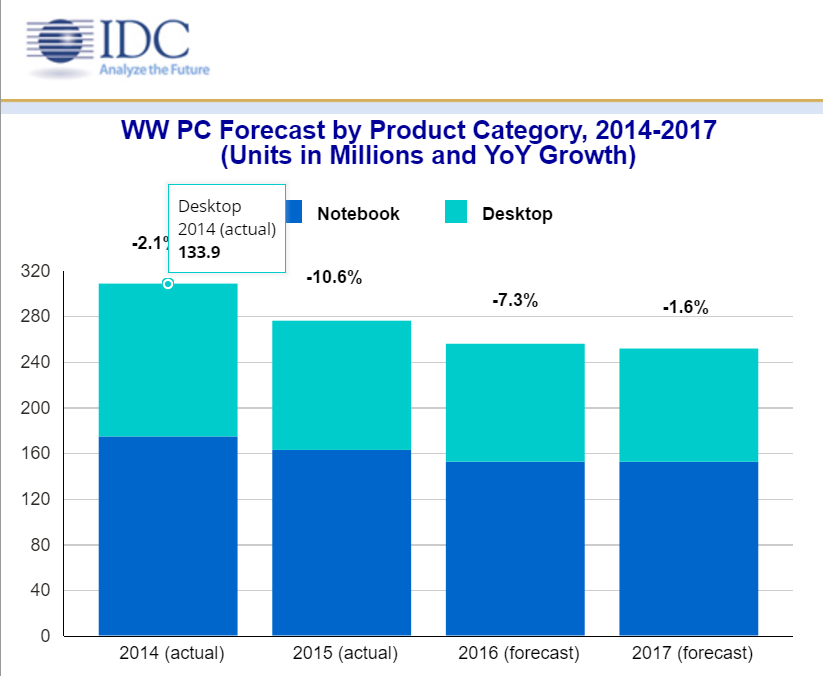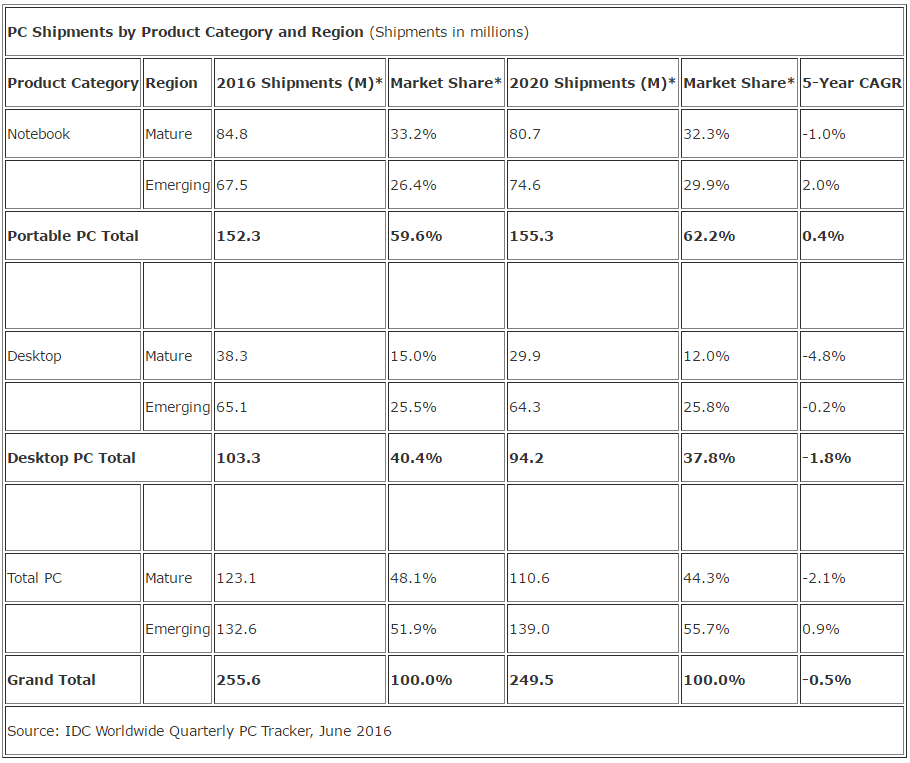IDC Slashes Wordwide PC Shipment Guidance, Windows 10 Upgrades Hurting Sales
The dreary PC market received yet another downgrade as the IDC restated its Worldwide Quarterly PC Tracker projections for the remainder of 2016. The restatement comes on the heels of a larger-than-expected decline in PC sales in the first quarter of this year. The bottom appears to be falling out of the PC market, which includes desktops and notebooks, at a more rapid pace than anticipated; it declined 12.5 percent year-over-year instead of the projected 11.3 percent in the first quarter.
The 12.5 percent drop is worrying, but the fact that this appears to be a sustained trend is even more troubling. The PC market declined nearly 11 percent in 2015, and the IDC projects a 7.3 percent fall in 2016. The IDC cited several factors that are contributing to the headwinds, including weak currencies, depressed commodity prices, political uncertainty and delayed projects. The tablet and phone markets continue to recede as well, so the continued slump is not coming at the hands of competing devices.
Surprisingly, the company also noted that free Windows 10 upgrades are a significant factor to the sluggish sales volume, as users do not have to buy a new PC to upgrade to the latest version of the operating system. Windows 10 is outpacing Windows 7 adoption by 145 percent, which represents the fastest adoption rate of an operating system in the company's history; upgrades topped 270 million users in the first eight months alone.
The free Windows 10 upgrade is certainly pushing the adoption rate uphill, but the fact that the operating system is lightweight enough to run well on many older PCs is not helping, either. The majority of modern operating systems and applications run well enough on older hardware for mainstream users to forgo hardware upgrades. Microsoft might be able to staunch the bleeding by curtailing the free upgrade program, but it has not announced any plans to that effect.
The desktop PC segment is experiencing the most drastic declines, while the notebook segment is subject to contractions that are more modest. In 2015, 162.6 million notebook PCs shipped, and the IDC predicts that 152.3 million notebooks will ship in 2016. The desktop PC segment accounted for 113.2 million units in 2015, but IDC projects that the segment will slide to a mere 103.3 million units in 2016, and to 99.2 million in 2017.
"The latest update reflects continuing pressure on PC shipments, but does not significantly change the factors driving the market," said Loren Loverde, Vice President, Worldwide Tracker Forecasting and PC research. "In addition, we have now had four consecutive quarters of double-digit volume declines. This type of prolonged slump is unprecedented, and lowers the bar for some improvement going forward. Unfortunately, the PC market still faces some persistent challenges, and for now, improvement continues to mean slower declines."
The IDC, like the majority of the analyst firms, does not expect growth to return to the PC market in the near or long term, instead predicting a -0.5 percent five-year CAGR (Compound Annual Growth Rate).
Get Tom's Hardware's best news and in-depth reviews, straight to your inbox.
The PC industry is already roiling. Intel recently fired 11,000 employees in the midst of a vast restructuring initiative that is designed to reduce its reliance on the desktop PC market. The latest market restatements will likely spur another readjustment of the stock prices of the major PC vendors, along with the entire food chain of secondary suppliers, such as storage, GPU, CPU and DRAM vendors.
For now, the only hope for the PC market (and desktops in particular) is for the bleeding to slow enough for the market to stabilize and exhibit some sort of predictable and rational behavior. However, that glimmer of hope seems to be fading with each new restatement.
Paul Alcorn is a Contributing Editor for Tom's Hardware, covering Storage. Follow him on Twitter and Google+.

Paul Alcorn is the Editor-in-Chief for Tom's Hardware US. He also writes news and reviews on CPUs, storage, and enterprise hardware.
-
slamattoms Windows 10 Adoption rate would not exceed win7 if they didn't have the pushy tactics that are in play.Reply -
Scott_89 "Surprisingly, the company also noted that free Windows 10 upgrades are a significant factor to the sluggish sales volume, as users do not have to buy a new PC to upgrade to the latest version of the operating system"Reply
Because with previous versions upgrades weren't possible? You had no choice but to buy a whole new computer? -
spiketheaardvark I think the bigger issue is illustrated by fact that after 5 years I have no plans to upgrade my i7 2600. We've past good enough for everything the average user does years ago. Now even enthusiasts are finding the time between compelling upgrades is getting longer. Even phones are starting to reach the point of "good enough".Reply -
vern72 After, how long, 20 years of PC sales increases it is finally starting to decline? That's a pretty good run if you ask me.Reply -
mapesdhs SPIKETHEAARDVARK wrote:Reply
> Now even enthusiasts are finding the time between compelling upgrades is getting longer.
And meanwhile Intel kicks prices through the roof, with no new features or anything to make an upgrade worth bothering with. Meanwhile, MS jumping into bed with Intel to lock newer tech to Win10 minimum is making older hw more attractive; those who don't want to upgrade are more likely to consider a hw purchasing decision that will allow them to stick with Win7/8 for a long time, which might be why I've seen some used items increasing in value recently. -
InvalidError Those effin' analysts perpetually ignore the elephant in the room: most people don't need new PCs because their 5-7 years old PCs are still good enough for the bulk of what they do on an everyday basis, unlike 10+ years ago where most people still needed a new PC every three years just to keep up with increasingly content-intensive websites, make basic stuff like office apps work smoother and handle more compute-intensive CODECs.Reply -
arossetti I would think the real reason is that as CPUs have become more powerful, the life span of a typical system has increased, while the processing power needed by the average user has stayed the same or even decreased. Most people read email, surf the web, and some word processing.Reply
Even if they are doing more CPU intensive tasks, the current generations are viable for several years.
I doubt it truly has anything to do with Windows 10. -
XaveT Reiterating what InvalidError is saying... There's no reason to upgrade old hardware. The new stuff just isn't good "enough" for it to be necessary. Take my AMD 1075T. 6 core at 3GHz. Old instructions. No speed difference I could see between it and an i5-6600 I made for an associate for her work. Sure, it's "better", you just can't tell under most circumstances. There needs to be a nice breakthrough in speed/performance/something so we don't yawn ourselves into computer apathy.Reply -
mapesdhs The rise of GPU acceleration has also made CPU performance in mainstream systems much less relevant, eg. video playback and conversion, streaming, etc. Same effect for rendering in some pro markets.Reply
-
innocent bystander These days I scaled back. I'm up for a complete platform upgrade after 7 years, so it'll be a Skylake i5 6500 and a GTX 1070... I'm expecting another video card upgrade in 5 years and another platform switch in 10. That's the reason. Even for higher end use cases (games), older tech is more than good enough.Reply
Hell, I could easily wait out another 2-3 years on my Phenom II X4 965 but the upgrade opportunity presented itself so why not?
I'd like IDC to start reporting on sales of the Likes of ASUS, Gigabyte and MSI to get a feel for the DIY market. I reckon it's a lot more stable than the Dells and HP's of the world.

